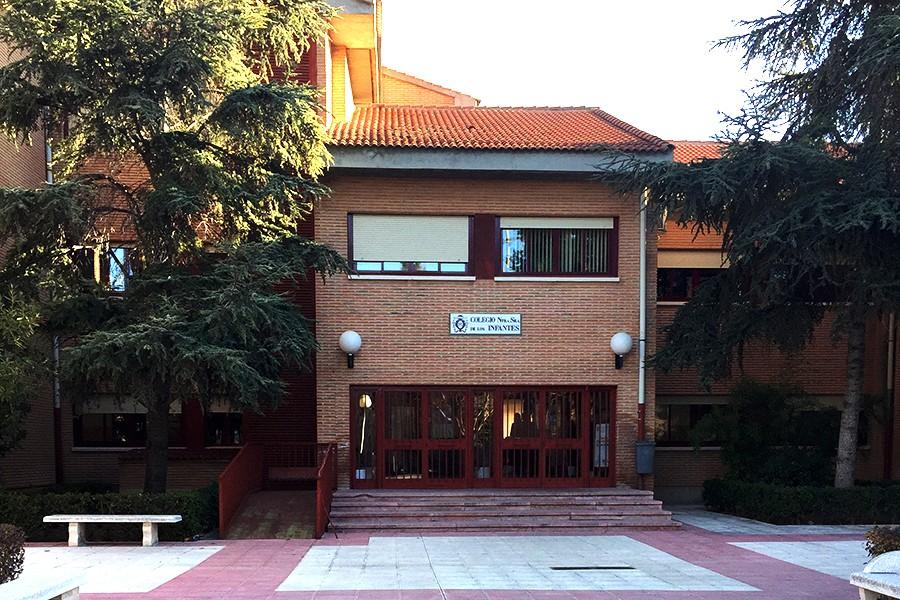Op-Ed: Students explore strange land of Infantes
This shows the main entrance of the private, Catholic Spanish school called Colegio Ntra. Sra. de los Infantes. Different class levels head to separate buildings each day.
From Jan. 22 to Feb. 9, I went with 21 other students to Spain. We were each reunited with a student at Colegio Ntra after they had stayed with us in Sept. Sra. de los Infantes and lived with his or her family. Each weekday I accompanied my Spaniard, Andrea Ortiz Pisoi to her school, where she and I split up so we can both get work done during the day. However, the school was completely different from what I was used to. Below are the many differences that all us Americans had to wrap our minds around.
Classrooms: JC
Students in Infantes stay in the same room the whole day … I know. Rather than moving from class to class like students at JC do, they stay put while teachers move to different rooms. Because of this, students keep their books in their designated room (they don’t have lockers) and there are no decorations, since many teachers use the rooms. No doubt, I prefer JC’s version. The classrooms are more personalized and welcoming. Plus, I believe I would go crazy if I wasn’t allowed to move around for hours.
Lunch: Infantes
Lunch, or “comida” for Spaniards, is at three in the afternoon for Infantes. During the school day, they bring or buy a sandwich during their break to tide them over. I prefer this to JC’s cafeteria because the snacks my Spanish family packed me were enough to keep me from being hungry until lunchtime. Comida, however, isn’t on the school grounds. Rather, students either are picked up to go home and eat or go out and buy food. I certainly ate more times during the day in Spain than in America.
Start of the school day: Infantes
It was amazing waking up an hour later than I usually do. It does wonders having the sun up as you head into school—it actually seems like it’s time to get work done. The school day for Infantes students starts at nine in the morning, instead of JC’s painful eight o’clock. The hour difference makes a huge impact in the winter and on my motivation. If I could, I would attempt to change JC to Infantes in this regard.
Sports- JC
Infantes doesn’t have any sports teams. Being an athlete, I would not like this one bit if I attended the school. However, there are students who choose to play a sport that’s separate from Infantes. That is definitely a good alternative, but in my opinion it’s easier to have one’s school be your destination for activities. It saves a lot of time traveling, and everything is right there. Then again, JC has a lot more ground to use and many fields, whereas Infantes does not.
Computers- JC
Students in this Spanish school don’t have laptops for their learning like we do. They resort to the ol’ notebooks, pens, and pencils for all their notetaking. Occasionally they’ll have online tests, which require the use of the school computers, but other than that it’s just pen and paper. While on this subject, may I bring up WiFi? Well, now. The school does indeed have WiFi, yet won’t let students in on the password. Yes, this is smart to keep students focused, but it would drive me insane. Then again, the students don’t have laptops, so there’s really no point for the access to the internet.
Grade levels: JC
If one went to school at Infantes, you would be in four different grade levels by the time you graduated. The first five years you would be in “infantil,” then graduate to “primaria” where you would be for six years before moving on to “secundaria” for four years. After “secundaria” comes your last two years in “bachillerato.” So basically, if I went there I would be spending 17 years of my life in the same school. I would honestly get sick of the same people and the same school for that many years. On this subject, I prefer JC’s four years to Infantes’ 17.
Uniform- Infantes
Uniforms are ‘pro-choice’ for “secundaria” and “bachillerato,” but not for the first eleven years of school. Basically, kids have to wear uniforms but they become optional for students in “secundaria” and “bachillerato.” This sounds fabulous. Uniforms make it easy to not have to decide on an outfit, yet sometimes I have just the right clothes in mind and wish to show it to the world (or school). While most students who have the option choose not to wear the uniform on most days, they still have the choice.
Elizabeth Driver is a Copy Editor for The Patriot and jcpatriot.com.



